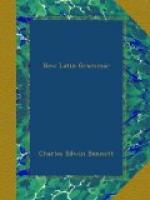4. An exception to Rule 3 occurs when the two consonants consist of a mute followed by l or r (pl, cl, tl; pr, cr, tr, etc.). In such cases both consonants are regularly joined to the following vowel; as, a-gri, vo-lu-cris, pa-tris, ma-tris. Yet if the l or r introduces the second part of a compound, the two consonants are separated; as, ab-rumpo, ad-latus.
5. The double consonant x is joined to the preceding vowel; as, ax-is, tex-i.
QUANTITY.
5. A. Quantity of Vowels.
A vowel is long or short according to the length of time required for its pronunciation. No absolute rule can be given for determining the quantity of Latin vowels. This knowledge must be gained, in large measure, by experience; but the following principles are of aid:—
1. A vowel is long,[6]—
a) before nf or ns; as, infans, inferior, consumo, censeo, insum.
b) when the result of contraction; as, nilum for nihilum.
2. A vowel is short,—
a) before nt, nd; as, amant, amandus.
A few exceptions occur in compounds
whose first member has a long vowel; as,
nondum (non dum).
b) before another vowel, or h; as, meus,
traho. Some exceptions occur,
chiefly in proper names derived from the
Greek; as, Aeneas.
B. Quantity of Syllables.
Syllables are distinguished as long or short according to the length of time required for their pronunciation.
1. A syllable is long,[7]—
a) if it contains a long vowel; as, mater, regnum, dius.
b) if it contains a diphthong; as, causae, foedus.
c) if it contains a short vowel followed
by x, z, or any two consonants
(except a mute with l or r); as, axis,
gaza, resto.
2. A syllable is short, if it contains a short vowel followed by a vowel or by a single consonant; as, mea, amat.
3. Sometimes a syllable varies in quantity, viz. when its vowel is short and is followed by a mute with l or r, i.e. by pl, cl, tl; pr, cr, tr, etc.; as, agri, volucris.[8] Such syllables are called common. In prose they were regularly short, but in verse they might be treated as long at the option of the poet.
NOTE.—These distinctions of long and short are not arbitrary and artificial, but are purely natural. Thus, a syllable containing a short vowel followed by two consonants, as ng, is long, because such a syllable requires more time for its pronunciation; while a syllable containing a short vowel followed by one consonant is short, because it takes less time to pronounce it. In case of the common syllables, the mute and the liquid blend so easily as to produce a combination which takes no more time than a single consonant. Yet by separating the two elements (as ag-ri) the poets were able to use such syllables as long.




